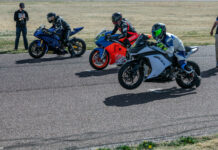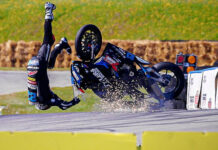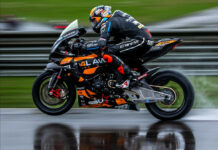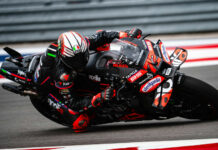Copyright 2018, Roadracing World Publishing, Inc.
FIRST PERSON/OPINION: An Interview With Danny Walker
By David Swarts
Former road racer Danny Walker owns what was the Genuine Broaster Chicken Honda team, and says the circumstances that led to his team’s withdrawal from the MotoAmerica Superbike Championship threaten every other non-factory team in the series, and possibly Superbike racing as we know it.
“The Marelli [Magneti Marelli MLE electronic engine management] system and the current status of the rules…caused us to be in this situation,” said Walker.
“It’s not American Honda’s fault. They gave us a couple of years and they did everything they could to help us try to be successful,” Walker said in an exclusive telephone interview with Roadracingworld.com. “And to try and blame it on my crew that just pisses me off. The crew did everything they possibly could.
“Between Ten Kate’s [Red Bull Honda World Superbike Team] two riders, Jake [Gagne] and [Leon] Camier, and PJ Jacobsen [Triple M Racing Honda World Superbike] – all those motors were done by Ten Kate – those guys blew up almost 20 motors this year.
“The only mechanical DNF that we had was a valve spring on one of last year’s heads broke on [Jayson] Uribe at Miller [Utah Motorsports Campus]. It still didn’t kill that motor, but it definitely lost that cylinder and we had to swap it out. That’s it. That’s a pretty crazy testament to Scotty’s [Jensen, Walker’s Crew Chief/Engine Builder/Data Engineer] work ethic on those things.”
Walker’s team and rider Jake Gagne won the 2014 AMA Pro Daytona SportBike Championship on a Red Bull/RoadRace Factory Yamaha YZF-R6, and the next season Gagne dominated the 2015 MotoAmerica Superstock 1000 Championship, winning 11 of 16 races on a Red Bull/RoadRace Factory Yamaha YZF-R1.

Jake Gagne was second-quickest in MotoAmerica Superbike Superpole at New Jersey Motorsports Park in 2016 in spite of riding with relatively unsophisticated engine control electronics on his Yamaha YZF-R1. – Photo by Brian J. Nelson.
“We’ve gotten some grief. Some people have said you picked the wrong rider [in 2018, Cameron Petersen]. ‘You should’ve picked a better rider’,” said Walker. “Some dude on the Internet, you know how guys are on the Internet are, told me [by hiring Petersen] we were being cheap and wanted to save money.
“We tested with a couple of people on our bike. Even on our old bike, Cam rode the heck out of that bike. He was pretty quick at the Sonoma [pre-season] test. He was right there at the Barber [pre-season] test. We were pretty pumped. He was riding the heck out of the thing.
“We [tested with] Josh Hook on the thing. Josh rides the F.C.C. TSR Honda World Endurance bike, and Cam outshined him by a long ways. So I don’t think our demise…we didn’t do [Petersen] any favors, but I don’t know who we could’ve put on that motorcycle. I don’t care who we would’ve put on that thing, it would’ve been really difficult for anyone.”
In the end, however, Walkers says it was a lack of results that ultimately led to his team losing crucial support from American Honda and being forced out of racing.
Although he showed some flashes of brilliance during qualifying sessions and in some races, Petersen had 10 top-10 finishes and a best race result of fifth in 20 races during 2018. Bobby Fong, who jumped on one of Walker’s Genuine Broaster Chicken Hondas for the final three rounds of 2018, added four more top-10 finishes and a best result of sixth-place in his six races.
So if it wasn’t a lack of sponsor support, a lack of crew competency, or a lack of talent on the part of his riders, what caused Walker’s team’s lack of results in 2018?
“The Marelli [Magneti Marelli MLE electronic engine management] system and the current status of the rules are pretty much what has caused our whole dilemma and caused us to be in this situation,” said Walker.

The dashboard display of a Magneti Marelli advanced engine control electronics system. – Photo by Corey Coulter/GeoCrash Photography, courtesy of RoadRace Factory.
The technical rules governing the FIM Superbike World Championship and the MotoAmerica Superbike Championship were very similar in 2018. Both limited motorcycles to using either a stock Engine Control Unit (ECU) with or without software and programming changes (a.k.a. a reflash); a “Superstock 1000” ECU (like one of Yamaha’s tunable YEC engine control units); or a single, mandated advanced “Superbike Kit” system designated by the manufacturer who homologated the motorcycle to run in the series.
According to the 2018 MotoAmerica rulebook, the “Superbike Kit” system is supposed to be “a complete package including all electrical/electronic parts not supplied on the homologated motorcycle required for full operation of all strategies – except the wiring harness” with a capped price of €8,000 (about $9,000 USD), excluding taxes.
“You’re supposed to buy the system for €8,000,” said Walker. “But it literally just comes with the dash, the IMU [Inertial Measurement Unit], the ECU and one dongle for communication. And then you have to have someone who will supply you with the software. It comes with nothing. It comes with absolutely, positively nothing. It’s pretty frustrating. It’s kind of a waste.”
Walker and his team had gone down this road before in 2016, when they stepped up from winning the MotoAmerica Superstock 1000 title and joined the MotoAmerica Superbike class, running a Yamaha. Walker bought the approved Superbike Kit electronics for the Yamaha, and sent Crew Chief Jensen to Magneti Marelli in Italy for training at the factory. But using the Magneti Marelli electronics still ended up being “a nightmare,” according to Walker

Genuine Broaster Chicken Honda’s veteran Crew Chief Scott Jensen. Jensen was one of the top privateer racers in the AMA Pro Superbike Championship before he changed course and became a professional crew chief. – Photo by Corey Coulter/GeoCrash Photography, courtesy of RoadRace Factory.
“Finally at Road America when it sent Jake [Gagne] off the track with the throttle stuck [open] going into Turn Five, at that point I was like, ‘No, we’re going home to regroup. I don’t want to kill this kid’,” said Walker. His crew then removed all of the Magneti Marelli electronics and replaced them with a YEC kit ECU on Gagne’s YZF-R1, and Gagne used the less sophisticated system to finish the season with strong results.
At Utah Motorsports Campus, Gagne qualified sixth in Superpole, just 0.7-second off the pole position time and finished fifth in Race Two, beating Josh Herrin. Then at the 2016 season finale at New Jersey Motorsports Park, Gagne qualified second, just 0.173-second behind factory Yamaha rider Josh Hayes and turned the second-quickest lap of Race One, in which he finished sixth.
“The guys from Crescent [Yamaha World Superbike Team] said, ‘Yeah, you should have never gotten the [Magneti Marelli] system’,” said Walker. “It wasn’t ready for the public. It had too many errors in it and the firmware was constantly doing crazy things and throwing error codes. Pretty much every time he would ride it on the track it would throw an error code and something else would turn off or turn on.”
But according to the rules, if Walker wanted to use an advanced engine electronics system, his only choice was the Magneti Marelli system homologated by the Crescent Yamaha team in 2016, and the same rules limited his choices in 2017-2018.
Heading into the 2017 season, Walker landed two-year deals with both American Honda and Genuine Broaster Chicken that provided the budget he needed to go Superbike racing. But the new Genuine Broaster Chicken Honda team chose to start off with a reflashed stock ECU.

Jake Gagne (32) raced for the win on his Broaster Honda in the wet-dry 2017 MotoAmerica season finale at Barber Motorsports Park. – Photo by Brian J. Nelson.
“There weren’t any electronics available for the Honda [CBR1000RR SP2],” said Walker. “The only thing potentially available was the HRC kit box, and the HRC kit box at the time got some really bad press because that’s what hurt Guy Martin and John McGuinness. So we didn’t want to run that.
“So all we had the option of doing was the reflash thing, and we went with [FT ECU], but that new Honda had so many security things in it that nobody had ever dealt with before, and we had mixed results. We didn’t feel like it was too bad, but it would do weird things like shut off the quick-shifter all by itself.
“It wasn’t a testament to my crew at all. I can’t even tell you the amount of hours they spent on that thing trying to make that happen. It was alright. At the end of the year when Jake almost won that race at Barber we were like, ‘This thing’s running pretty decent now. We’ve got a pretty good handle on most of the weirdness that it did.’
“But the only way that motorcycle would even run was we had to leave the ABS plugged in. It didn’t work, obviously, but we had to leave the ABS plugged in. And we had to zip-tie the key fob to the motorcycle. It was like your car. If the key fob wasn’t within a meter or so it wouldn’t start and it wouldn’t run. We tried all season to get rid of that stuff, but you couldn’t do it without the thing not running.”
Gagne did well enough on the Broaster Honda CBR1000RR SP2 that he got recruited as a fill-in rider in 2017 for the Red Bull Honda World Superbike factory team, and then was signed as a full-time rider for 2018. That led Walker to sign former team rider Cameron Petersen to ride his Honda in 2018.
Knowing the team was upgrading the engine significantly for the new season, Walker said he felt he also needed to upgrade the electronics to make the Honda truly, consistently competitive. So, between the 2017 and 2018 race season, Walker said he went to Europe and made new direct connections with Honda Motor Europe and their parts suppliers, and America Honda agreed to pay for the acquisition and development of a new advanced electronics system. But again, Walker only had one choice — a Magneti Marelli system that the Red Bull Honda team hadn’t even started using when the 2018 season began.
The problems mounted when a long delay in getting new engine parts prevented Walker’s team from shipping a completed race engine to Magneti Marelli’s tuning partner in Italy, Rossi Racing, for pre-delivery mapping and set-up. That resulted in the Broaster Honda team receiving its Magneti Marelli electronics four days before its truck left Colorado for the first race of the 2018 season, at Road Atlanta.
“So we talked about it,” said Walker. “‘Do we start off on last year’s system and then wait to try to get this thing developed? Or do we just jump in?’ We thought, the longer we postpone using the Marelli, the longer it’s gonna take us to get it done and be competitive. So we literally stopped at our track here, High Plains Raceway, and tested for half-a-day before the truck headed to Atlanta.”
Walker’s team struggled to get the Magneti Marelli electronics working effectively during the early rounds. “We went to COTA this year with a motorcycle that made 42 rear-wheel horsepower more than we had [at the start of] 2017,” said Walker. “We went from 180 to 222 horsepower and our bike was 10 kph slower, and it was all the electronics!
“We thought that having that tie-in and having Honda Motor Europe and those guys involved at Ten Kate, ‘OK, we’re going to get a pretty good package out of the gate.’ That was not even close to the case. It wasn’t even close to how it worked out.”
Walker said Jensen then took the system in a different direction than the Red Bull Honda World Superbike team, and Petersen started making progress with his confidence, speed and results. That progress came to a screeching halt when the Magneti Marelli ECU suddenly locked the Broaster Honda crew out at the start of the event at Utah Motorsports Campus (UMC).

Cameron Petersen (45) looks back at Utah Motorsports Campus where his team got locked out of both of its Magneti Marelli ECUs. – Photo by Brian J. Nelson.
“Vicente [Pechuan-Vilar], who works for Honda Motor Europe, is just a really awesome dude,” said Walker. “He is crazy smart. He came over and spent a lot of time with us at Laguna, which was awesome. He came over and spent a day with us here [at the race shop in Colorado] helping us kind of get through the system a little bit. And he came to Utah.
“Friday morning we show up and Vicente is plugging into our system with his laptop and all of a sudden the thing won’t read or write. The thing is locked up. So they scramble really quickly before the first session to swap out the ECU. And then when Cam came in and Vicente plugged into the new ECU that one completely locked. So before the first session at Utah was even done our ECUs were completely locked.”
Walker said his Magneti Marelli ECUs still allowed the bike to work, but the strategies (traction control, anti-wheelie, engine braking, etc.) that were programmed in for Laguna Seca were still active and couldn’t be changed. And because the system works on a distance basis (i.e. how far the bike is from the start/finish line), the settings for the undulating 2.2-mile Laguna Seca circuit were not working very well at the fast and wide 3.0-mile course at UMC.
“He [Pechuan-Vilar] spent all weekend on the phone and e-mailing Marelli and talking to people trying to figure it out, and they couldn’t figure it out,” said Walker. “He had gotten some new software from Marelli in his laptop and that’s the only thing we could think of [that might have caused it]. We had never had any problem [like that] prior to that with Scotty, and we didn’t have any problems after that.
“He [Pechuan-Vilar] took one [ECU] with him and we kept one so our bike would still run. And Marelli told him, ‘We’ll probably get to it by the end of September or the beginning of October.’ We’re like, ‘What? Hold on a second? What?’ And then they [Marelli] went on vacation for the whole month of August. Literally the only way we were able to go racing at Pittsburgh was we had to borrow an ECU from Triple M Racing. They were nice enough to send us their second system. They only had two.
“We never did get our second system [back] from [Magneti Marelli]. We had to rent a [second] system from [Magneti] Marelli USA, an older system, or otherwise we wouldn’t have had two bikes at New Jersey or Barber. I still haven’t gotten it back.”

Cameron Petersen (45) got the holeshot and briefly led MotoAmerica Superbike Race Two at New Jersey Motorsports Park. – Photo by Brian J. Nelson.
Walker says the current rules governing MotoAmerica Superbike electronics should be changed.
“If you look at the rules for the Australian Superbike class, which is closer to Superstock, and there were 38 bikes on the grid at Phillip Island for the races they had in conjunction with MotoGP,” said Walker. “British Superbike has a full grid and they use a spec Motec system that doesn’t have all that extra stuff [traction control, wheelie control, etc.] in it. And they have multiple riders and bikes winning.
“You look at those rules and look at those classes. I know it’s different markets and different places, but I would think the Australian series would have to be similar to our program here as far as [manufacturer] involvement and financing, support levels and they’re getting 38 guys and we’re getting, what, 18, maybe.”
Asked if it would work better if advanced electronics were outlawed and Superbikes were limited to reprogrammed stock ECUs and readily available race kit electronics, Walker said, “I’m not a Marelli fan at all. The Marelli system that almost caused our team to go under in 2016 has now caused us to close the doors and sell everything in 2018. And I’ve got smart dudes. Scotty is amazing with how much he can do with that stuff. Vicente wanted Scotty to come over to a couple of races this year and help the Triple M guys because he had such a good handle on the program.
“There’s, what, only six guys in [America] who can make a motorcycle run on the Marelli system. How many bikes can they put on the grid if each of those guys does two bikes? One bike with a Marelli is a full-time job, just to make the thing do what you want it to do, let alone trying to do all the data and suspension and everything else that you want to do with the electronics. Just the engine mapping is a full-time job for one guy.
“But there’re just too many other outside variables. You can’t get any support [from Magneti Marelli]. There’s no support, especially for us. The only support we could get was from Honda Motor Europe, from them. So if we needed anything we had to e-mail them and [wait for] an e-mail response.
“Customer service, they [Magneti Marelli] have no idea. Customer service? ‘Your software jacked up our ECUs. We sent them to you and you didn’t even have enough time to look at them, even though that’s all we had and our bike won’t run without it. So hey, thanks!’”

Cameron Petersen (45) and Bobby Fong (50) at the 2018 MotoAmerica season finale at Barber Motorsports Park. – Photo by Corey Coulter/GeoCrash Photography, courtesy of RoadRace Factory.
Walker said he couldn’t come up with an exact cost because American Honda paid for some things directly, but he said the total amount of money spent on his team’s electronics during 2018 was “definitely over six figures.”
When asked how much it would cost to run a reflashed ECU for a season, Walker said, “2% or 3% of what we spent on the Marelli system. They [Magneti Marelli] are not going to be happy with me telling you this. They have been trying to keep me quiet all year. ‘Please don’t tell anybody this.’ Yeah, because you don’t want anybody to know what the deal is. The only thing I can say that I think MotoAmerica is doing wrong is their electronics rules for Superbike. And I believe that it will be the demise of the class until they change those rules.”






